Rhodes Nyanga Historical Exhibition (Rhodes Museum)
The Exhibition is located in the Rhodes Nyanga National Park in the beautiful Eastern Highlands The building is known as Rhodes Stables, built in 1897 by R Marks a stonemason, for Cecil John Rhodes. It was used by Rhodes for the stabling of horses and mules during the several visits which he made to Nyanga during 1897 and 1900. Rhodes was deeply impressed with the beauty of the countryside and the prospect of establishing agriculture. He purchased land on which to erect a stone house and stables. Here he stayed from time to time, directing experiments with a wide variety of crops, and initiating schemes for running livestock.
On his death in 1902, his Nyanga Estate was bequeathed in trust to the nation. The original stables and shed, etc., were unused for years until a committee was set up under the National Trust to create a museum on this historic site. During the years 1971 to 1975 the committee, with dedication and hard work, collected photographs and articles of historic interest relating to Rhodes and the development of the area from earliest times, restored the dilapidated structures and established a historical exhibition.
In May, 1974 the National Trust Zimbabwe acquired, from the Government, the right to occupy the building for the public display of manuscripts, photographs and other exhibits of interest relating to Nyanga and persons and events connected with its history and development. The exhibition was officially opened by the Hon MHH Partridge on the 8th of November 1975. At that time the President of the National Trust Zimbabwe was Sir Athol Evans K.B.E, BA, LLB.
An Act to provide for the development and maintenance of Rhodes Estate by National Parks was passed in 1978, and both Rhodes Nyanga Hotel and Rhodes Nyanga Historical Exhibition (Rhodes Museum) are leased from National Parks.
For some years the museum remained static, until 2011, when the National Trust of Zimbabwe renovated the buildings and established a local committee of volunteers which proceeded to restore and update the Exhibition – a project which is on-going. The present committee is drawn from all sectors of the community, and encourages community participation. Members (some being pensioners), generously give of their time, expertise, equipment and fuel. Some members travel 50km each way to attend meetings.
The earlier displays included early Manyika Africa culture, early European contacts and the first years of colonial rule, fallen heroes and tribal chiefs, Chief Tangwena and the struggle for Zimbabwe and the development of the Nyanga tourism and agricultural industries. The exhibits have been expanded and now show the cultural history of the area from the Stone Age to the present day, including recent displays on traditional leadership and pottery in archeology. Artifacts, period furniture and clothes, and articles on general history of the locality are on display. The committee aims at developing the museum into an educational facility, especially for young Zimbabweans but also of interest to adults and visitors from other countries. With this in mind entrance fees have been kept to the minimum, in particular with respect to groups of school children.
The building also contains a collection of archaeological material from the Nyanga district. Rhodes’ equipment and household furniture.
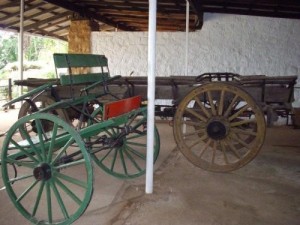
A small room between the stable (main exhibition hall) and the wagon and implement shed, was originally the harness room. In 2013/2014 it was renovated (thanks to assistance from the Don Grainger Trust) and is now the Don Grainger Reading and Research Room. Valuable reference books on the flora and fauna of this country and its neighbours, and on many other subjects have been donated and are now available for use by students and research workers. Memorabilia from the life of humanitarian Don Grainger is also on display.
Space become a major problem as the collection continues to grow and new projects are undertaken. The committee decided to renovate the loft which is immediately above the museum, and sourced funds from DAP Australia to proceed with the project. An external staircase was fitted for access to the second floor loft and sky lights were fitted into the roof.
The RNHE is not state-aided and has to rely on the goodwill of donors for any capital development. Monthly expenses are often difficult or impossible to meet i.e. wages and rent to National Parks. A small shop sells curios, craft work, maps and booklets of historic interest, on commission.
The extension was officially opened on 26th April, 2014 and has transformed the former animal fodder storeroom into a much-needed additional extension to the Museum. The loft has been named “The Petheram Room” in memory of Dick Petheram, author of the publication, “The History of Rhodes Nyanga Estate”, who was responsible for procuring the original Rhodes’ memorabilia and establishing the Museum in the 1970’s for the National Trust of the then Rhodesia.
The National Federation of Women’s Institutes of Zimbabwe donated a small collection of valuable badges plus funds with which to construct a secure glass cabinet to display the articles, and to make a display board for the history of the WI, with particular reference to the growth of Homecraft and other African Women’s Clubs in Manicaland. The committee strive to provide a sense of connection between the past and the present in Zimbabwe, and serve as a springboard for the future. Donations or loans to the Exhibition of articles, books, photographs and documents are gratefully accepted.
The Museum enjoys visitors all year round and school groups throughout the school term times.
In 2014/15 further display boards were included and a display of photographs, grains and lists of “Traditional Foods” was added to “Traditional Tools and Implements” and “Traditional Musical Instruments”. A Children’s Reading Area was also established in the Younger Visitors’ space.
In early 2015, with funding from the International National Trusts Organisation, a Cultural Heritage Education project commenced. The project focuses on heritage management and is a community-led cultural program. The project saw the development and dissemination of educational materials and information to the visitors of the RNHE and also implemented youth heritage education and provided an area where small groups participate in ‘Cross Cultural’ programme raising public consciousness of the value of Zimbabwe’s cultural heritage, see further details below.
Operating Hours and Entrance Fees:
The Exhibition is open every day except Tuesdays, Easter Sunday and Christmas Day.
Opening Times: 8.30am – 5.30pm
Entrance fees: Adults – $2; Children under 12 – 50c
School groups: Primary Schools: $1 per 4 pupils
Secondary Schools: $1 per 2 pupils
Colleges: $1 per student
Teachers and Bus Drivers are free.
For more information contact:
Curator: 263-733147081
Chairman: 263 29 3195
Vice Chairman: 263 298 265;
Secretary: 263 29 2254
Emails: leecrofts@bsatt.com or geevee@bsatt.com
Members of the National Trust are entitled to special benefits.
SPIRIT OF PLACEMENT STATEMENT FOR RHODES NYANGA HISTORICAL EXHIBITION
Join the many people that visit the unique public display of ancient manuscripts, photographs and other exhibits of interest relating to Nyanga and persons and events connected with its history and development.
Connect with the past as you wander around the fascinating exhibits on show inside a historical building known as Rhodes Stables, once used for the stabling of horses and mules, part of Cecil John Rhodes’ Nyanga residence.
Enjoy the memorabilia depicting the life and times of early Zimbabwe, from the Stone Age to modern times together with the art, culture and traditions of this beautiful area.
Come and enjoy an insight into life as it was then!
Activities on offer at the Exhibition
Visit the historical permanent collection and regular curated exhibitions, visit the shop for local crafts.
Directions to the Rhodes Nyanga Historical Exhibition
The Museum is situated next to the historic Rhodes Inyanga Hotel, in the Nyanga National Park.
Take the Rusape to Nyanga main road for about 90 km where you will see signposts to the historic Rhodes Nyanga Hotel. The Historical Exhibition and curio shop are located next door to the hotel.
GPS Reading
18° 17′ 26.5″ S
32° 43′ 47.28″ E
Exciting Historical Exhibition: Collection of Traditional Shona Sculptures: August 2018
By Edone Anne Logan
‘The Yawn Dog’, ‘The Mighty Eagle’ and ‘Hongwe’s Ponder’ are a few of the fascinating titles given to Jonathan Matimba’s traditional Shona sculptures that are enriching the display at the Rhodes Nyanga Historical Museum. The late Jonathan Matimba is one of the three most famous and influential stone and wood carvers of the 1950s and ‘60s.
‘Seed Pod’, ‘Morning Love’ and ‘Flying Dream’ describe some of the modern pieces of work, crafted by our Nyanga and Claremont sculptors, giving an interesting contrast to the onlooker. Most of the modern artists are sons or grandsons of famous sculptors of the last century: Joram Mariga, Manyandure, Takawira, Sande and Chaudiringa, many of whom were brought up in the Nyatate area of Nyanga North, and sold their work locally and overseas.
At the Official Opening of the Exhibition on 13th August 2018, Mr Naboth Machopa enthusiastically introduced Dr.Jonathan Zilberg. Dr Zilberg, Associate Research Scholar at The Centre of African Studies, University of Illinois, then gave an exhilarating talk on the history of Nyanga sculpture, mentioning the importance of women such as Miriam Mbwaburi, who sold woven reed mats at the local hotels in the ‘50s. Miriam was encouraged by the Rural Council to establish the Nyanga Craft Village and to invite potters and sculptors to join her.
Dr. Zilberg explained to the audience, which consisted of local folk, sculptors and their families, some important points which make sculptures appealing to buyers. During the weekend he spoke with many of the artists, encouraging them and giving helpful advice.
A record number of visitors took advantage of the Open Day by touring the Museum, and enjoyed the refreshments. This special exhibition has been extended from the intended closure on the 14th August 2018. The Matimba family is happy to leave the work at the Museum for a few months.
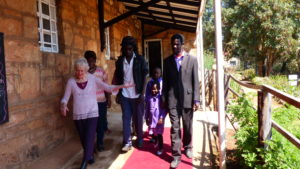 Mrs Edone Anne Logan welcoming members of the Matimba family
Mrs Edone Anne Logan welcoming members of the Matimba family
The idea and inspiration for the exhibition came about thanks to Dr.Zilberg, who visited Zimbabwe last year and made us more aware of the wealth of talent – historical and modern – which we have in our area. On a trip into the Nyatate area, north of Nyanga, we were grateful to have be introduced to one of Jonathan Matimba’s sons, Munetsi who took us to the Matimba homestead where Mrs Matimba is still alive. You can just imagine our surprise when we arrived there and saw the extraordinary wooden sculptures. Then, even more amazingly, Munetsi dug his hands down into his granary and started pulling out his fathers’ stone sculptures. He told us that his father, Joram Mariga and Bernard Manyandure had gone to school up the road at Mt Mellory Mission School and that they had all learnt to carve there.
The family agreed to let us display some of Jonathan’s works for as long as we wish, in order that they can be seen and appreciated by the public. The transport of the works of art from the Matimba’s homestead was kindly made possible by a donation from Mr Rob Burrett.
The discovery of this unique collection and this being the first exhibition of the artist’s works is of great significance and of national historical interest. We are very proud and privileged to display these rare early pieces of art for public enjoyment.
Annual Report April 2018 – March 2020
2018 was a difficult year for the Committee of the RNHE and as Chairman, I wish to repeat my appreciation to Mrs Merle Moore (Vice Chairman), Mr Geoff Hawksley (Treasurer), Mr Marshall Nyanhanda (Curator) and all Committee Members – past and present – for efficiently maintaining the smooth running of the museum.
The biggest challenge of the year was the compilation of the Zimbabwe Time Line – from pre-historic times to the present day. Each committee member chose a period and researched the main historic events, with emphasis on events in this area where applicable. Pictures were copied from magazines, booklets, newspapers, etc, mounted, labelled and laminated. The period from Independence to the present was compiled very ably by the teachers and pupils of the history department of St. Monica’s School Nyanga, to whom we are most grateful.
Josephine Machopa June Weeks, Dalray Bailey and Merle Moore Naboth Machopa
This project was prompted by the Curator, who had received requests from teachers visiting the RNHE with school children, to create a simple time line, to bring to pupils of all ages an awareness of the history of this country through the years. I wish to commend all members on this worth-while display; we receive regular expressions of appreciation. The time-line should be kept up-to-date, and changed at intervals to retain interest for regular visitors.
The display depicting the history of the Nyanga Churches and Missions has been slowly expanded and improved, with further research undertaken and photographs added. Pictures of some outlying missions are still needed.
It is the intention of the Committee to undertake Heritage projects whenever possible. Last year we were invited to join with Uganda and Sierra Leone in an INTO cross-border competition which encouraged children to question and do research into customs and traditions. It would be almost impossible to organise a project such as this in the Nyanga area without a ‘liaison officer’ who is in contact with every school. We are most fortunate to have as an ex-officio member, Mr W Dhlandhlara (SOLON Foundation), who fills this position for us, and enabled us to participate in this project. Pupils from the Heritage Clubs were encouraged to create a short video depicting their chosen subject, using a cell-phone. Some worked in groups and others individually. The videos were judged initially by a local panel and the best submitted to a panel of school children. The three videos with the most votes were submitted to the INTO group. The best videos were shown at a Prize-Giving Event organised by Mrs Moore and Mr Dhlandhlara. NTZ and SOLON funded the lunches and Mrs Waterworth organised the certificates. There were monetary prizes which went to the Heritage Clubs, and three individual prizes. Our gratitude goes to INTO, the teachers involved, Curator, the judges and committee members and to NTZ Councillors who attended the event.
Welcome speeches by Mrs M Merle, RNHE Vice Chair and Mr W Dhlandhlara of the Solon Foundation
Mr W Dhlandhlara, Mrs EA Logan, RNHE Chair, Mr D Scott, NTZ Chair presenting one of the prizes
Students waiting for the results Mr D Scott, NTZ Chair addressing the students
Mrs S Waterworth presenting one the prizes Happy students and NTZ Councilors!
Following the lecture and journey of exploration in 2017 to Nyanga North to visit the homes of early Nyanga Sculptors by Dr Jonathan Zilberg, (Associate Research and Scholar for African Studies), the family of the late Jonathan Matimba offered Jonathan’s work to RNHE for display. Dr Zilberg and Rob Burrett assisted with the funding of the project and the works of art were transported to the museum in August. This culminated in an Open Day and Exhibition of the works of Jonathan Matimba and local sculptors, who were given the opportunity of displaying their work at the exhibition; some sales were made. Dr Zilberg spoke to the large gathering of visitors and artists on Nyanga’s early sculptors, explaining different styles, materials and techniques. The Committee is now discussing how the widow of Jonathan Matimba can receive some reward for the loan of the works of art. Dr Zilberg presented RNHE with one of the wooden sculptures – The Yawn Dog. A professional video has been compiled by Iain Macdonald as a valuable record of this important event.
Welcoming speech by Mr N Machopa and presentation by Dr J Zilberg
Dr Ines Grainger donated the funds for a new sign for the door of the Grainger Room , to commemorate the 100th Anniversary of the birth of Don Grainger. A summary of the life of Don Grainger was printed in the John Galt Gazette. This excellent local publication advertises free of charge, monthly news from RNHE and articles of general interest re recent displays, etc.
Dr Ines Grainger and Head Teacher, Hartley School by the Pre-history display
Dr Ines Grainger and niece, Georgina Falcone from Argentina, Merle Moore Secretary and Aubrey Logan Committee member
The Curator and Student on attachment have updated the inventory documentation and donation records on the computer. They have prepared most books in the Grainger Reading Room for cataloguing; this project needs to be completed and students encouraged to make use of the excellent collection of books for research purposes.
As public interest increases in the museum, so does our opportunity of spreading information and helping to make the world a better place! Mrs Matimba was given a wheel-chair from Rotary, through Councillor Clare Peech, as a result of the sculpture exhibition;
Dr Ines Grainger donated copies of her Women’s Club recipe books to a club organiser in Harare who visited RNHE, for use by members.
Dr Ines Grainger talking to Mr Nyanhanda Curator
Rob Burrett’s historic booklets have become ‘best sellers ‘ from the museum shop, with some visitors asking for the latest publication to add to their collection. Rob has also written an excellent booklet for schools on Rock Art, funded by the French Ministry of Foreign Affairs, particularly for the Mukuvisi Woodands Environmental Project. 400 copies were given for distribution to Nyanga Schools.
As a result of our enquiries and research into the history of the Dutch Settlement, an excellent illustrated document has been written by someone who grew up in that area in the 1950s/60s, which can now be used for information on this previously un-documented area and era of Nyanga’s history.
Visitors have requested more information on the Natural History of Nyanga, and the Committee is planning a display to depict this.
As a grand finale to our year, we moved, with great difficulty, a Portable Steam Engine donated by Aubrey Logan, from Juliasdale to RNHE, with the assistance of Mr Steve Lapham, Mr Sibanda of National Parks and his tractor driver, the Curator and a number of good, strong men! The renovated and painted Engine (exported from UK to SA in 1903 and pulled by oxen to Bindura district in 1904) is happily settled in the Wagon Shed, next to the Ox Wagon.
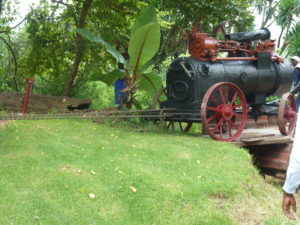 Arrival at Rhodes Hotel and kindly towed to the Museum by National Parks tractor
Arrival at Rhodes Hotel and kindly towed to the Museum by National Parks tractor
Good wishes go to Marshall Nyanhanda with his studies by correspondence for a Bachelor of Science honours degree in Development Studies – under the Faculty of Social Sciences. We have enjoyed the company of our student on attachment –Meshullam Mudzedze, and will miss her presence at the museum. She has worked well and matured in confidence over the past ten months, and we wish her well as she continues with her studies in Archaeology, Museum and Heritage Studies.
Naboth Machopa Vice Chairman, Meshullam Mudzedze Student on Attachment and Marshall Nyanhanda Curator
Our thanks go to Management and Staff of Rhodes Hotel for their support of all our projects and for generously lending their cups, urns and chairs for functions. The Hotel also accommodates the Curator and his family, for which we are most grateful.
To David Scott, Sharon Waterworth and the members of the NTZ Council, our thanks for your continued support and advice. Our thoughts are with Mrs. Helen Hyslop as she struggles with health issues. Helen advised and encouraged us through those first difficult years, and we miss the contact with her.
To the new Committee of the RNHE – my very best wishes for the future; may you gain as much enjoyment and satisfaction from your museum work as have Aubrey and I !
Newly-elected Officers – Guy Cary: Chairman, Merle Moore: Secretary, Josephine Machopa: Treasurer and Naboth Machopa: Vice-Chair
Edone A Logan
Chair 2018 – 2019
Footprints: I am indeed awed by what Edone, first Chairperson of RNHE, and Aubrey Logan and their successive committees and donors have achieved to make such a remarkable museum. The RNHE is the only NTZ museum in the country: it is our duty to maintain and develop it as a unique showpiece.
The present path: Numerous donations have graced our shelves, floors, nooks and crannies over the past year: the Punch Library of Humour from Merle Moore and her late husband Nigel; a 170-year-old executive desk first owned by Sir Benjamin Greenacre, Mayor of Durban, and latterly by his (recently late) great-grandson John, from whose collection of 18 exquisite chess sets a fascinating African one, made of intricately-crafted wire, was chosen for the Museum. The magnificent, wondrously carved ‘Greenacre desk’ now serves proudly as our grand Reception desk.
Much care has been taken into rejuvenating our small entrance garden, litter collection, labels and signs, and the Curator’s unsolicited restoration of wooden railings all add to a positive ambience and attract favourable response.
Hearty tribute is due to our small, determined and enthusiastic committee for their constructive ideas, practical input and generously-given time over this past year. We have been delighted to welcome Nyasha Makanza – Manager of Rhodes Hotel to our ranks.
Student on Attachment Meshullam Mudzedze reading the Curators Report, Treasurer Josephine Machopa and Rhodes Hotel Manager Nyasha Makanza
Challenges: The shortages of fuel and rapid decline in value of our local currency over the past year have had a catastrophic impact on our attendance levels, particularly by school parties: schools (and parents) have to budget for ‘outings’ and educational trips well in advance but, by the time they arrive, our very modest entrance fees have become unaffordable for them and we do not have the heart to turn them away.
To be of real use and amongst the greatest of such needs is to be of educational value – to old and young – means more than being merely ‘fascinating’ or cluttered.
In numerical terms the vast majority of our visitors are young people, eager to be captivated and to learn. We must grasp and build on this educational opportunity within this Museum, as an adjunct to the international award-winning outreach already achieved, led so commendably by Edone Ann Logan and her assistants.
Pupils from Hartley Primary School, Chegutu
Needs: A Regional Information Centre. A small 50-seater lecture/video-theatre, of simple construction and comfortably appointed with carpeted steps and a large flat-screen TV for school children, andpublic lectures. This is something we believe we now need and it’s appropriately educational! Relevant material has already been researched and prepared.
Two other needs are the resurfacing of the Shed’s floor, and replacement of outside steps up to the loft.
Something we are striving for in Rhodes Museum is to achieve a balance in what we display. It is important that we portray significant players and events in our history from Lobengula to Tangwena, from Welensky to Mugabe, from the Mashona rebellion to the liberation struggle – all as part of the boundaries laid down by Rhodes 130 years ago. We have been awakened to this need, surprisingly, by children visiting the Museum who say, “Who were the people ruling this country before Independence in 1980? We want to see them and know about them, too.” Boundless scope here for additions to the informative Time Line already set up – and for our video theatre!
Projects: We are planning a new brochure – one which we hope will ‘capture’ people irresistibly. With this in mind, we have had a lot of photographs taken professionally both in, and of, the Museum – photographic ‘hints’ of what is to be found here.
The Nyanga region is home to a variety of creative crafts-people: here are to be found wood-carvers, sculptors, weavers, nurserymen and furniture-makers. One of our projects is to give such people the greater exposure they deserve, by holding on-site ‘Craft Days’ over public holidays when visitors can see them at work (and hopefully buy).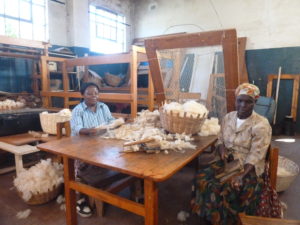 Cecilia Korafati and Shillah Chimbandidza of the Nyanga Zuwa Weaving Cooperative carding the wool obtained from a Troutbeck farmer
Cecilia Korafati and Shillah Chimbandidza of the Nyanga Zuwa Weaving Cooperative carding the wool obtained from a Troutbeck farmer
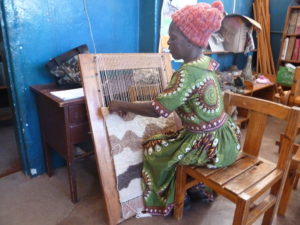 Rose Chandiringa completing a beautiful woolen carpet
Rose Chandiringa completing a beautiful woolen carpet
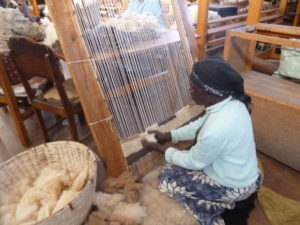 Joyce Matongo starting to weave a carpet
Joyce Matongo starting to weave a carpet
One aspect of Nyanga’s history which has been largely overlooked by our Museum is the “Old Dutch Settlement” of Nyanga North, dating from more than a century ago. We mustn’t allow this significant part of our local history to slip into oblivion.
Finally, we here in Nyanga live in a paradise of wild flowers. One of our hopes is to celebrate this natural beauty, in Rhodes Museum, by displaying copies of Mary Clarke’s comprehensive and meticulous paintings of local indigenous flowers – perhaps those relevant to each month.
Guy Cary, Chair, 2019-2020
Annual Report April 2017 – March 2018
May I begin with a complimentary paragraph taken from a report written by Archeologist/Teacher/Historian/Editor, Mr Rob Burrett, after a visit to RNHE and World’s View in April, 2017.
“Since my last visit in April 2014 the RNHE has expanded by leaps and bounds, both in quantity of material displayed and the quality of its content. It is becoming one of the more important historical depositories in the country. The team that has put it together must be commended for an excellent job. I was delighted to see the large number of visitors who were there the day I visited it (Easter Saturday 15th April 2017). It was diverse in ethnicity and age. The interest being shown by the African population is especially gratifying. We hope that this will encourage them to become more actively involved as this heritage belongs to us all and their engagement will ensure the long-term viability of the project”… We thank Rob for this encouragement and advice, and financial assistance when most needed.
Over the past year we have had two visits from Mr Scott and NTZ Councillors, all of whom have been helpful and supportive throughout. In June Dr. Jonathan Zilberg, an authority on the history of Shona Sculpture , visited Nyanga and spoke to members of the Committee on the well-known Nyanga Sculptors of the last century. We were able to visit the homes of these men and meet family members. This has led to an offer by the son of one sculptor to let us use some of his father’s work to display in the museum.
Dr. Jonathan Zilberg
In June Rob Burrett again spent time in the area, partly assisted by SOLON Foundation, undertaking field work at some isolated Nyanga schools, and speaking to teachers and senior students on the importance of their cultural heritage. He was able to explore heritage sites and give advice on protecting the sites.
Archaeologist Rob Burrett discusses a field trip to pit structures in Cumberland Valley with Johnny Stockdale
Recently the focus of our Committee has changed slightly from purely improving and enlarging the Historical Exhibition, to encouraging Cultural Heritage projects in local schools. We were delighted in November when a presentation of our 2015 heritage project was made by NTZ at the International National Trust Conference in Bali, and was voted the best project! This encouraged us to participate in a Cross-borders Heritage Project with Uganda and Sierra Leone, which involved school children using their cell phones to take short video clips of any heritage or traditional activity. This was well supported by the schools, and thanks to a crowd- funding appeal through INTO, we were able to give monitory prizes to individuals and Heritage Clubs which produced the best videos.
Great interest is being shown already by the many school children who visit the museum.
Two young visitors in the Children’s section Visiting students in front of the Victorian section
Various displays have been moved and up-dated. A section on saddelry and horses is being created with donations from members of the community. More valuable books have been donated to the Reading Room. We are grateful to all members of public who give interesting and historic articles to display.
The RNHE signage has been renewed, thanks to NTZ. The garden is looking lovely with new lavender replacing the old plants, plumbago flowering well outside the wagon shed, protea planted in the beds and generally a good make-over by Dal Bailey.
Before closing this report I wish to express my appreciation to Mrs Merle Moore, Vice-Chairman, who is holding the reins this year, organising special events with the support of the Committee Members and dealing with problems, correspondence and the general running of the museum. Marshall Nyanhanda is keeping the exhibits, buildings and wash-rooms clean and tidy and also dealing with the visitors, including large groups of school children, extremely well. Mr Geoff Hawksley holds the purse strings and somehow manages to pay our monthly expenses in this difficult financial climate.
To each and every Member and Ex-Officio Member, I wish to express sincere gratitude for your support and friendship – and hard work.
Edone A Logan.
Chairman RNHE
Report for RNHE November, 2016
Looking back over the past eventful year, we are happy to realise that progress has been achieved in a number of areas.
- We now have a wheelchair ramp! Organised by Area Manager, Onias Bepe and built by the Parks carpenters and builders, the wooden ramp leads from below the Grainger Reading Room to the side door of the main display area. A concrete path runs from the car park to the ramp. The wooden railings protecting the wagon shed have been replaced, which has enhanced the appearance of the area. We are indeed grateful to Parks for these improvements.
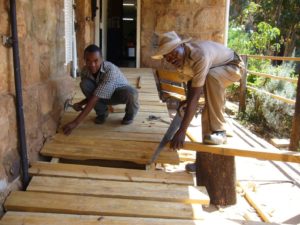 Construction of the wheelchair ramp
Construction of the wheelchair ramp
- National Parks provided the Museum with its own ablution block! This was desperately needed as visitors have had to use the Hotel facilities in the past. Our gratitude to Rhodes Hotel for accommodating our visitors for so many years. Thanks too, to the committee members involved in erecting an attractive wooden screen, and azalea plants to give some privacy.
- Dhlandhlara and Mr. Funk of the SOLON Foundation donated a new COMPUTER to RNHE. We need not enlarge on the difference this will make to the efficient administration of the Museum. Our deep gratitude goes to SOLON. This has enabled Curator Marshall Nyanhanda to digitilise our records and keep an accurate and up to date acquisition register.
- The Zim community continues to donate articles of historic interest for displays. A collection of ‘grandma’s soft toys’, handmade bed-jacket, curlers and stationery wallet; ancient bottles made of thick glass; plaited leading reins and well-known old cookery books are among the articles donated We added a genuine paraffin-box dressing table to the early child’s bedroom. Two beautiful display cabinets have been donated. Many more valuable Rhodesiana books have been received, some of which are in need of repair, and all were in need of cataloguing. Mrs. Adele Hamilton-Ritchie took time off from her work in a Harare to spend a week in Nyanga entering 1100 books into the computer. We are extremely grateful to Adele for undertaking this onerous task. Adele also printed out the Dewey System of cataloguing, for our future use.
- The Shop, under Annie Wilkes’ supervision, is selling historic booklets and maps, traditional pots, locally woven mats and sculptures, curios and preserves. Although the proceeds do not amount to a great deal for the Museum, the shop attracts visitors and adds a little to the income account.
- Work was completed on the Outline History of the National Federation of Women’s Institutes of Zimbabwe and African Women’s Clubs. We are grateful to Jane Fearn, daughter of Peggy Fearn, the WI member who established the first Homecraft Clubs in Mutare, for spending time in Juliasdale helping to sort through boxes of documents, letters, photos, etc. for the display.
Curator Marshall Nyahanda and Jane Fearn work Jill Frow assisting with the History of the on the Homecraft Clubs exhibit National Federation of Women’s Institutes of Zimbabwe exhibit
- Edgar Nyagwaya has now completed two excellent documents which we are intending to copy and sell in the Shop:
- SHONA CUSTOMS AND CULTURE
- RELATIONSHIP BETWEEN COUNCILLORS AND TRADITIONAL LEADERS.
These we feel, will be invaluable for those who are interested in understanding and learning about Shona Traditions and Culture.
News on recent displays: A concise History of the National Federation of Women’s Institutes of Zimbabwe and the Development of Homecraft and Associated Women’s Clubs, with special reference to Manicaland, is now complete. Due to the incredible amount achieved over the past 90 years by women in this country, the task of choosing what could be displayed in a limited space was extremely difficult, but we hope that the display will serve as a lasting reminder of the dedication of thousands of women to the improvement of Home and Country.
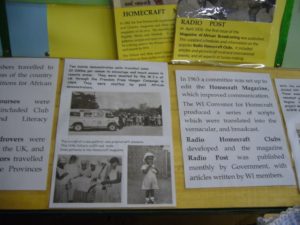 A section of the History of the development of African Women’s Clubs
A section of the History of the development of African Women’s Clubs
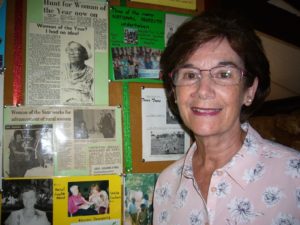 Denise Gaisford, WI Woman of the Year over 20 years ago, visits the WI exhibit from the UK, and finds her picture on display!
Denise Gaisford, WI Woman of the Year over 20 years ago, visits the WI exhibit from the UK, and finds her picture on display!
We have received some complimentary notes in the Donation/ Suggestion box which encourage us to continue working to provide a centre for the display of historic information, artefacts and articles of interest to all sections of the community. The increase in the number of bus-loads of school children visiting Nyanga from all parts of the country is most encouraging.
Cultural Heritage Project: Following the Cultural Heritage Project organized by the Rhodes Nyanga Historical Exhibition in 2015, funded in part by the INTO Small Grants Fund, we set up a display of some of the work achieved by the 130 children involved in the project. Most school Principals had not yet visited the RNHE to view the display as it is in the National Park, a little way out of Nyanga. Mr. Dhlandhlara, Area Director of SOLON Foundation, is deeply involved with the advancement of education in the region. He assisted with the organization of the 2015 Project, and helped with transport costs, certificates, etc. After discussing the possibility of the school Heads holding their monthly meeting in the National Park, Mr. Dhlandhlara organized this with the Chairman of the Group, Mr. Sithole. He again assisted with the cost of transport of personnel to the Park, and an excellent lunch after the meeting.
The meeting was held on Friday, December 2nd 2016 and Mr Dhlandhlara and I were given the opportunity of speaking to the group of Principals, 117 in all, on ‘The Importance of Heritage Education’, emphasizing the rich bounty of heritage resources in the Nyanga area. Following the recently introduced syllabus for Zimbabwe Schools on Family and Heritage Studies, we emphasised the importance of introducing the subject in the Early Childhood Development classes where the children are encouraged to ask questions about their family. The programme progresses to the study of their school, customs and traditions in their community, places of interest and traditional importance, their country and national heritage and later, international heritage issues. The involvement of elders or groups of elders should be included. With the new schools curriculum coming into being there is increased interest by the schools in culture and heritage education, and we are keen to be of assistance in this respect. Awareness of the importance of Heritage Education is becoming more and more prevalent world-wide, and we have been commended by INTO for encouraging heritage education in the area.
After the traditional lunch, the Heads visited the RNHE, primarily to see the Heritage Project display, but also to tour the entire museum. We hope their visit will encourage more Nyanga schools to plan visits to RNHE.
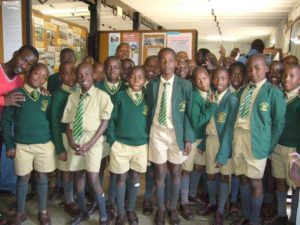 School children visit Nyanga from all areas of the country. The Rhodes Nyanga Historical Exhibition is included in the itinerary
School children visit Nyanga from all areas of the country. The Rhodes Nyanga Historical Exhibition is included in the itinerary
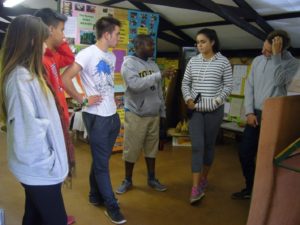 Rotary Students spend time in the museum . They showed special interest in the Heritage display
Rotary Students spend time in the museum . They showed special interest in the Heritage display
“Nyanga’s Rich Heritage” was published during the year by Khami Press .The object of the booklet is not only to promote the beauty of Nyanga but to give information on the ancient and modern history of the area in order to engender a deeper knowledge and understanding of the local resources. I was fortunate to have the opportunity of working with archaeologist Robert Burrett on the publication of this booklet. A number of Heads purchased a copy at the meeting and those who already had copies told us that, although they were born or had been in the district for many years, they were amazed at the information gleaned from the book.
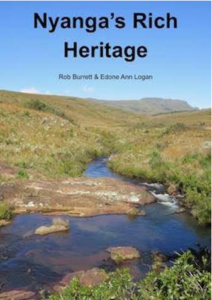
The Zimbabwe Ministry of Education emphasized the importance of heritage education in the curriculum for 2017 and we felt that the Heads welcomed this opportunity of learning more about the subject. With the new schools curriculum coming into being there is increased interest by the schools in culture and heritage education, and we are keen to be of assistance in this respect. We are hoping that this publication will be used by the schools for reference purposes.
Edone Logan
Chairperson
Rhodes Nyanga Historical Exhibition
Photographs of the Displays and Exhibits and of Visitors to the Museum: 2015
Update on Cultural Education Heritage Project, 2015
Introduction: David Scott, Chairman NTZ, invited Edone Logan, Chairperson RNHE, to meet with organisers of the Cross Cultural Foundation of Uganda in mid-2014. After an interesting and inspiring discussion the organisers offered to send to the RNHE, a copy of “The Heritage Education Toolkit” used by heritage clubs in Uganda’s secondary schools and other young Ugandans.
Having studied this document, copies were made and an outline of the RNHE Project drawn up, following the guidelines from Uganda, but adapting the details to the Zimbabwean context. NTZ suggested application be made to the INTO Small Grants Programme, and with assistance from NTZ Vice-Chair, Sharon Waterworth, the forms were submitted. In November the head of INTO Secretariat, Catherine Leonard, advised that we had been awarded the grant!
Willie Dhlandhlara, Director of SOLON Foundation, which is involved with programmes in local schools, expressed interest in the project and was tasked to find suitably positioned schools to participate in the programme. He chose one secondary school, Nyangani High School, and two primary schools, Nyamhuka Primary and Zvurabuda Primary. Each of these schools runs a Quiz and Heritage Club as an extra-mural activity, and it was the members of these clubs and the staff involved, who were chosen to participate. In all, 132 children were involved, with two teachers from each school.
The Ministry of Education was contacted to give permission for the pupils to travel after school hours off the school premises. The Area Manager of Nyanga National Park agreed to give the pupils free access to the Park. SOLON Foundation agreed to fund the travel expenses throughout the project.
An introductory meeting was held with the teachers, Museum Curator and Willie Dhlandlara, the programme explained and the Toolkit examined. Teachers were encouraged to come forward with suggestions, and were asked to prepare the children for the 1st session of Phase 1.
The teachers have prepared their pupils with excellence, and this has enabled the two hour sessions to be fully utilized.
It was decided to give the pupils good quality notebooks and pens for this project, as well as cool drink and buns or fruit as refreshments at each session.
PHASE 1 – Session 1
- i) Tour of Museum in groups, conducted by Curator, Marshall Nyanhanda.
- ii) My Self, my identity, place of birth, origin, beliefs, foods.
iii) My Family, and my family tree, maternal and paternal.
- iv) My Ethnic Group, Tribe, Totem, Customs.
- v) My Country, flag, crest, national anthem.
On arrival at the Museum most pupils were initially quite reticent, but as they realised that this was Fun and not just another school lesson, they relaxed and seemed to look forward to and thoroughly enjoy each session. Good interaction took place between children and adults, with lively demonstrations of various totem greetings, customs, eating traditions, etc. being discussed and dramatised.
Each child completed their family tree, having researched the details at home. They were encouraged to record stories from their grandparents. These will be displayed in the Museum. It was reported to us by the teachers that parents were pleased with the interest shown by the children in their family background.
PHASE 1 – Session 2
Visit to the Pit Structures in the National Park. The Curator of the site, an officer from Zimbabwe Museums & Monuments, delivered an excellent talk to each group of children, explaining the archeological findings of the origins of the Terrace and Pit Structures of Nyanga. The pupils were encouraged to explore the ruins and enjoyed going through the tunnel and structures. Good discussion followed on the importance of protecting and preserving historical sites: their National Heritage.
As a direct result of this visit, two different books on the archaeology of Nyanga were donated to schools in the area by different groups, to facilitate the teaching of ancient history by the history teachers. 100 copies of each book were donated.
PHASE II – Heritage Resources & Traditional Crafts in the Area
Session 1
Children met at the Nyanga Art & Craft Village and were introduced to Ernst Spare who leads the group of artists. He explained that the pupils would be mentored in groups of 4 or 5 by an artist, 11 in all. The artists demonstrated to the children the art of sculpting with different kinds of stones and tools. It was also explained that Nyanga was the birth place of Shona Sculpture in Zimbabwe, and it is important that the craft should continue with the youth. After the demonstration, pupils were paired off with their mentors to learn to sculpt an egg (juniors) or a mushroom (seniors) from a piece of raw stone.
A local potter, Lilian, was also present and mentored a group of pupils at each session They were introduced to different clay and simple tools, and each succeeded in moulding a coiled pot under her guidance.
Session 2
Once again, the children met at the Nyanga Art & Crafts Village and half the group completed their sculptured pieces, with sanding, firing, and finally polishing. Beautiful objects were produced, in all shapes and sizes with the magnificent colours of the different stones becoming apparent. It was heart-warming to see the pride on the faces of the young sculptors!
The pottery group under Lilian, built a traditional kiln with dry cattle manure and grass, which they collected nearby, and fired the pots which had been air dried over the past week.
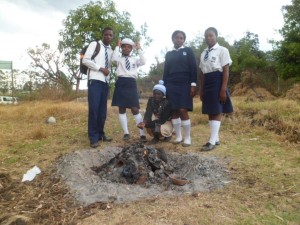
The other half of the group visited the Zuwa Weaving Co-Operative. Here the children were given a tour of the workroom by Rose Chandidza, and the other six members of the co-operative demonstrated the various stages of weaving, from washing, carding, dyeing, and spinning, to finally weaving on a loom to produce a small carpet. Some of the children tried the different stages in wool preparation. They were shown samples of leaves and other plant material used in the dyeing process.
Rose took the pupils to see the two small industries on the same premises, a welder and a carpentry shop, which are renting space from the cooperative , due to the harsh situation at this time. She explained the importance of learning a trade and working with one’s hands.
This group then changed with the other and completed their stone pieces or pots. The pupils were all delighted with their works of art which they proudly took home to show to their families.
Conclusion. The members of the Committee wish to thank INTO for the opportunity of undertaking this Cultural Heritage Project with three Nyanga schools. The initial exercise on ‘Who am I?’ is important in this changing society, and we hope it will encourage these children and others to take an interest and pride in themselves, their families and their nation.
We consider that the project has had a positive impact on the pupils and teachers involved, and has also given the local artists and craftsmen a sense of achievement to see the pleasure derived from giving children a new experience, new interest, and joy of accomplishment. We also hope that the visit to the museum and the ancient ruins will engender an interest and understanding of heritage sites. The Area Manager of Parks stated that this has been a most positive exercise in community out-reach, and he hopes it will continue.
Two schools have expressed interest in continuing with the project on their own, next year, and it is our hope that others will follow – giving their pupils an interest in activities out of the school precincts.
To conclude the Programme, it is planned to exhibit at the Museum, photographs taken throughout the sessions, and some of the children’s work. The pupils are planning to give the entertainment and the Committee hopes to raise sufficient funds to supply everyone with a traditional meal. November 28th coincides with the 40th Anniversary of the opening of the Rhodes Nyanga Historical Exhibition, and we are happy that this is being marked by the conclusion of the Heritage project.
Annie Wilkes and Edone Logan
The 40th Anniversary celebrations of the Opening of the RNHE
The 40th Anniversary celebrations of the Opening of the RNHE (or Rhodes Museum as it was then called ) together with the Cultural Education Heritage Project celebrations took place on 28th November 2015 in the National Park. The Project would not have been possible without financial assistance from INTO, the SOLON Foundation and NTZ, and the support of National Parks and Rhodes Hotel. A large exhibit of children’s project work – stone sculptures, clay pots, writing, art-work and models – was on display in the wagon shed, and as each group arrived they toured the Museum and examined the exhibit. A large collection of photographs taken during the sessions was compiled by the organizers. This entire display has been moved to the Petheram Loft for public viewing.
Pupils and teachers, members of the Zuwa Weavers Co-op, the pottery teacher and the sculptors from the Nyanga Craft Village were all transported to the Park in vehicles organized by Mr. Dhlandhlara and the teachers. After refreshments, everyone was ushered to the historic Rhodes Hall where the children were able to run down to the Rhodes Dam, and play in the playground. All then assembled in the Hall , short speeches were made and each school presented , from the stage, entertainment in the form of drama, recitation, singing or dancing. Every project participant was awarded a handsome certificate and the three schools were each given a large world map and set of Scrabble to keep in their Culture Hut at school.
The Traditional Meal, organized by Mr. Dhlandhlara with support from Mr. Bepe was excellent! The catering team (see photograph) prepared the delicious meal for 180 people with sufficient for some to take a little home! A happy and successful event altogether – thanks to everyone involved. Special mention must be made of the six teachers on the team; they were delightful to work with and to get to know. Professionals of a high caliber. Curator, Marshall Nyanhanda gave invaluable support to the Project and we commend him for his input.
Edone Logan
- Tributes to the late Edone Ann LoganEdone Ann, Chairman of the RHNE welcoming members of the Matimba Family NTZ Executive Members Tributes to Edone Ann Logan It is with great sadness that we report the passing of Edone Ann Logan on 1st March 2023, born 8th September 1939. Members from the Executive Council of The National Trust of Zimbabwe (NTZ) would like to extend ...
- THE RHODES NYANGA HISTORICAL EXHIBITION CELEBRATES ITS 10th ANNIVERSARYThe members of the Rhodes Nyanga Historical Exhibition committee, NTZ Executive Council members together with some key stakeholders proudly celebrated the 10th anniversary of the Museum in style with a wonderful event held in December 2021. The Museum has certainly come a long way since it first opened its doors to the public, the Committee would ...
- The Rhodes Nyanga Historical Exhibition featured in this Tourism Lookout videoWe have much pleasure in sharing a video produced by ‘The Tourist Lookout’ that featured the Rhodes Nyanga Historical Exhibition whist they were travelling around and highlighting the best ‘hidden tourist gems’ of the Eastern Highlands. The video shows Marshall Nyanhanda, the Curator showing the team around and being interviewed. Please Enjoy and share.
- Annual report April 2017 – March 2018May I begin with a complimentary paragraph taken from a report written by Archeologist/Teacher/Historian/Editor, Mr Rob Burrett, after a visit to RNHE and World’s View in April, 2017. “Since my last visit in April 2014 the RNHE has expanded by leaps and bounds, both in quantity of material displayed and the quality of its content. It ...
- Rhodes Nyanga Historical Exhibition – Spirit of Place StatementJoin the many people that visit an astonishing public display of ancient manuscripts, photographs and other exhibits of interest relating to Nyanga and persons and events connected with its history and development. In addition there is memorabilia depicting the life and times of early Zimbabwe, from the local indigenous tribe’s people, through to the ...
- Rhodes Nyanga Historical Exhibition Update August 2016A number of items have been donated which are always a welcome addition and boost to the existing collection. All donations are much appreciated and acknowledged, as they go towards building what is already a fine collection of memorabilia and history of the area. Following our gathering at Worlds View on the 23rd April – we ...
Article Featured in the The Zimbabwean Newspaper: February 2014
Nyanga Cultural Heritage Education Project: 2014
In late 2014 the NTZ was the lucky recipient of funding from the Small Grants Programme managed by the International National Trusts Organisation (INTO). The funding provided was to implement a Cultural Heritage Education project at one of our properties based in the eastern highlands namely: the Rhodes Nyanga Historical Exhbition (RNHE).
The project focuses on heritage management and will be a community-led cultural program. It will see the development of materials for education and build capacity within the NTZ and for the visitors to the RNHE. It will disseminate educational information to the visitors of the RNHE and also implement youth heritage education and provide an area where small groups participate in ‘Cross Cultural’ programme which will give the RNHE the opportunity of raising public consciousness of the value of Zimbabwe’s cultural heritage. The project is inclusive of indigenous heritage and the schools/youth outreach program will be implemented/extended.
We are very pleased to report that the Project is progressing well. The Program at the Museum was explained to the Heads of the local schools, who then discussed it with their staff, and then we decided which schools would be able to participate – logistically. The enthusiasm has been so encouraging, and we hope that this program will eventually be available for groups from all the local schools.
The teachers, from one senior and two primary schools in Nyanga, are all involved with their schools’ Heritage Clubs, and are most enthusiastic about plans to increase the range of activities for the members of these Clubs. They are keen to encourage the pupils to take an active part in the Museum research and displays, and with their input, we planned a program which includes visiting heritage sites in the area, experiencing hands-on traditional crafts, and most importantly, researching their own family histories, collecting stories from their grandparents, and finding their own identities within their ethnic groups. National Parks has agreed to be involved in the project, and will lead the groups on field trips. Other members of the community have agreed to talk to the children on Traditional Leadership, old and modern customs, archeology, the animals in the Nyanga Park, etc.
Prior to the commencement of the Project, and encouraged by the Museum Committee, SOLON provided each school in the area (60 +) with one or two copies of Robert Soper’s ”Terrace Builders of Nyanga”, and the Prehistory Society of Zimbabwe followed by donating Mr Rob Burrett’s “Shadows of our Ancestors” to each school. These have been gratefully received and the study of the unique prehistory of this area has been incorporated into the history curriculum.
Each school has been encouraged to record its own history, and we have received five of these documents to date.
We are fortunate in having Annie Wilkes on the Committee, experienced in teaching pottery in rural schools. Annie has volunteered to lead the Heritage Project for us, in spite of the fact that she lives many miles from the Museum. The Museum Curator, Mr Marshall Nyanhanda will be at each session and conduct the tours and participation in the Museum.
The Project has become far larger than we initially expected and we will have to purchase more stationery (with the INTO funds). SOLON is being very supportive and we rely on their knowledge of the local schools for advice and communication with the schools- many of which are scattered far and wide. They are also assisting with transport of pupils to the sessions.
At present we have three groups of 50 children. Each group will have two sessions at the Museum this term. The first session took place on June 17th 2015.
The Grant from INTO will add several new dimensions to the RNHE including the following:
– After the initial project start-up costs the project can be sustained from visitors’ entry fees and a small percentage of the NTZ shop profits;
– The project will provide an improved visitor experience;
– There will be a transfer of knowledge from the NTZ to the visitors;
– The project should attract more visitors thus strengthening the financial position and profile of the RHNE;
– The display of items/pictures/artefacts of particular interest to the younger visitors;
– The material will provide an opportunity of learning/experimenting with traditional/modern craft materials and techniques for the visitors and;
– NTZ members worldwide.
The main project outputs are as follows:
1) Training guides for the schools involved in the cross cultural programme;
2) A display of items/pictures/artefacts;
3) An area will be available allowing small groups to participate in the ‘Cross Cultural’ programme;
4) Materials such as clay, paint etc will be given in order to provide an opportunity of learning/experimenting with traditional/modern craft materials and techniques.
We wish to thank INTO once again for enabling us to proceed with a project we consider is important to young Zimbabweans in raising consciousness of the value of their own and their country’s cultural heritage.
We are certain that there will be many benefits from participation in the Heritage Project – some of which include increased understanding, confidence and esteem as an individual and as a member of a particular community and nationality, and appreciation and pride of cultural heritage at local, community and national levels. Respectful interaction with people from diverse cultural backgrounds – nationally and globally will be encouraged.
The Project also gives the RNHE and the NTZ the opportunity of raising public consciousness to the value of the National Trust and of Zimbabwean cultural heritage and it is our hope that the project may be imitated by others in Zimbabwe.
Edone Anne Logan
Chairperson RNHE Committee




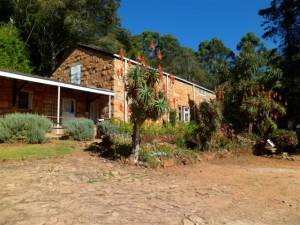
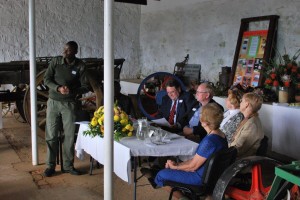
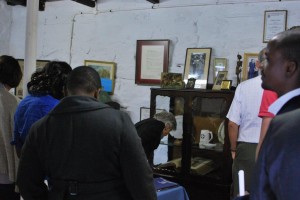
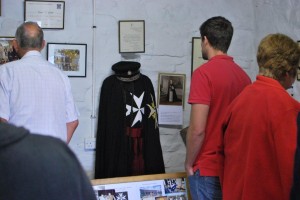
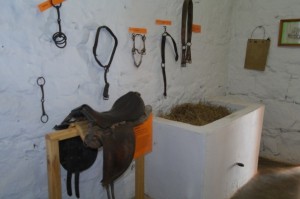
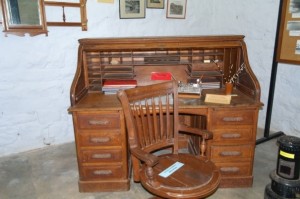
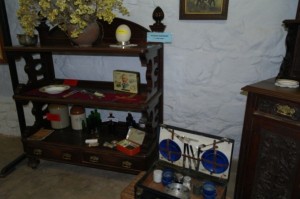
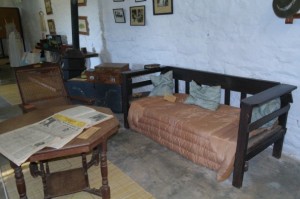
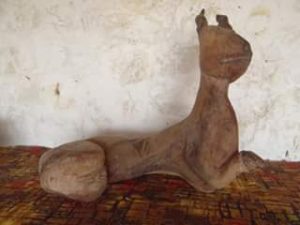
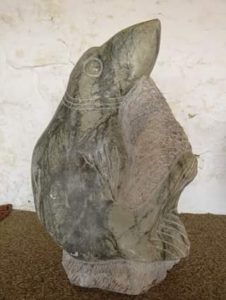
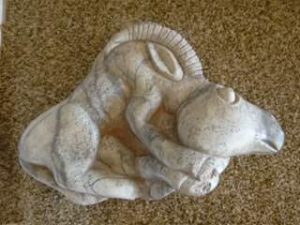
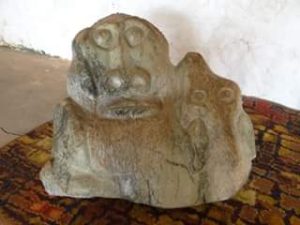
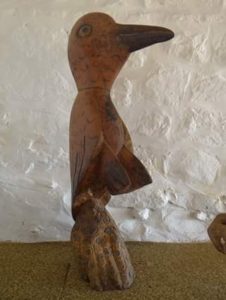
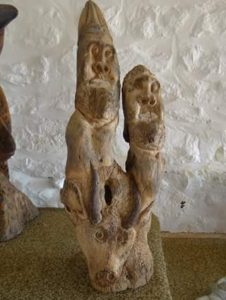
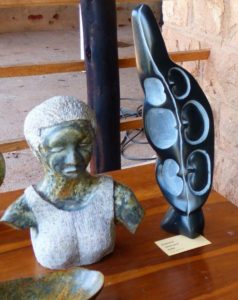
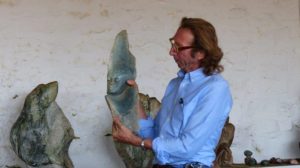
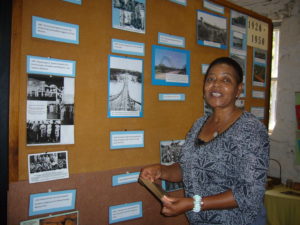
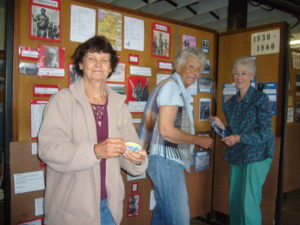
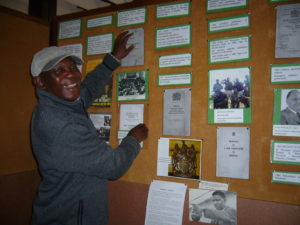
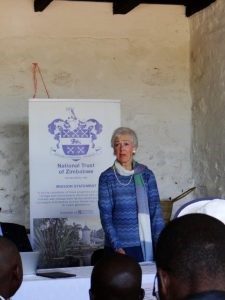
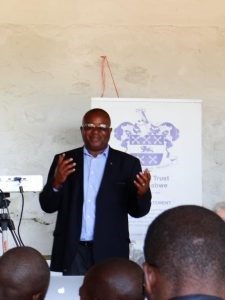
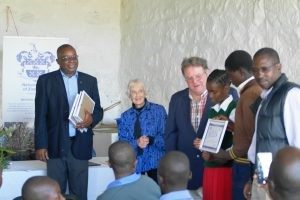
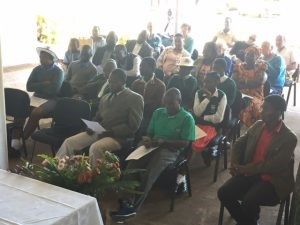
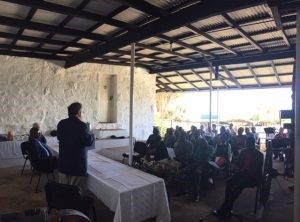
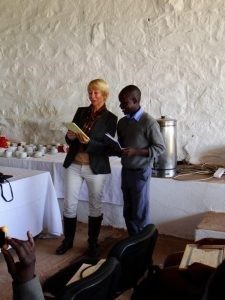
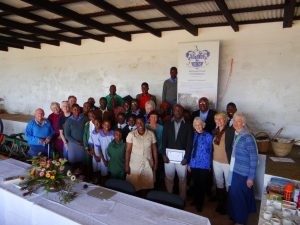
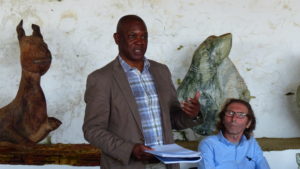
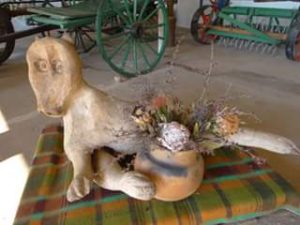
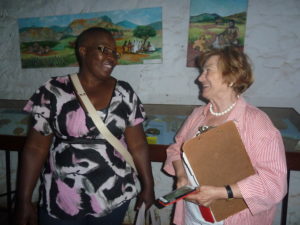
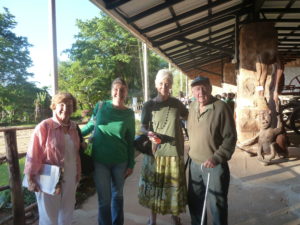
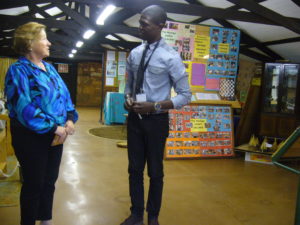
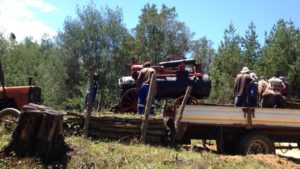
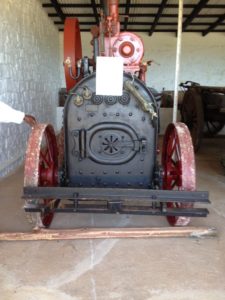
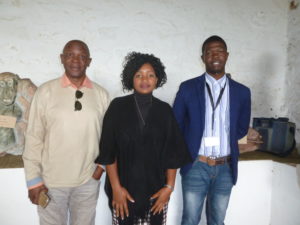
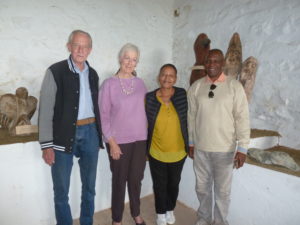
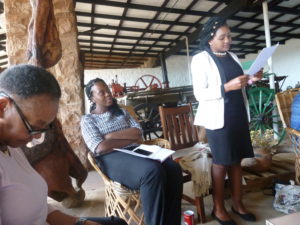
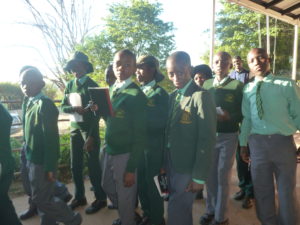
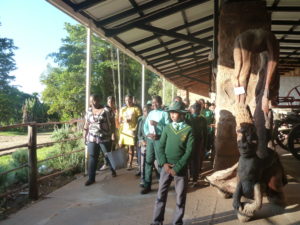
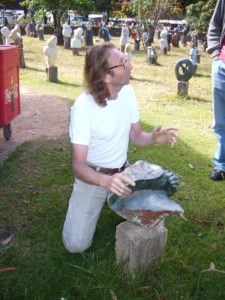
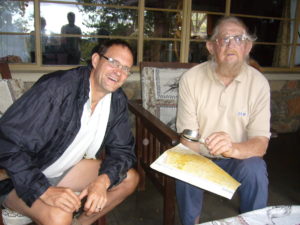
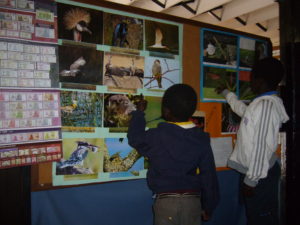
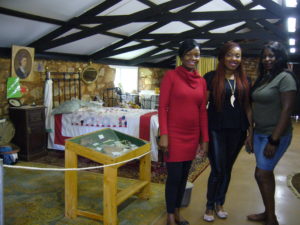
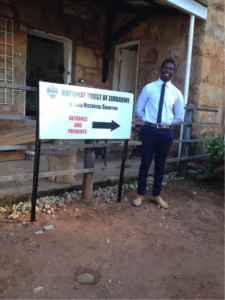 Mr
Mr 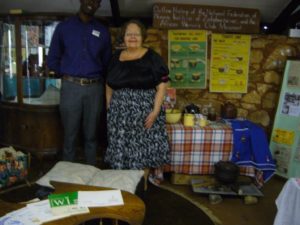
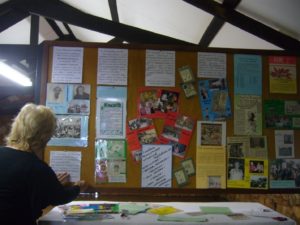
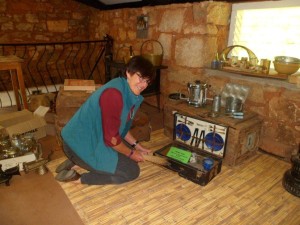
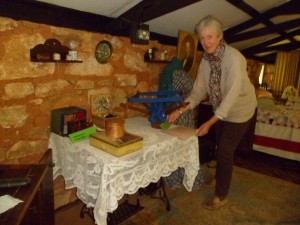

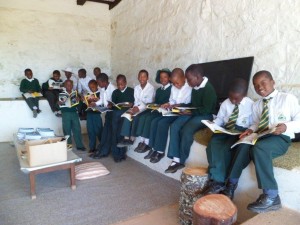
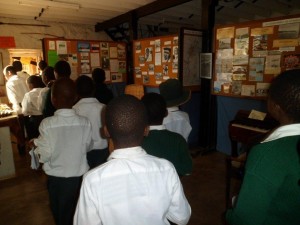
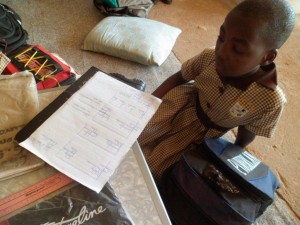
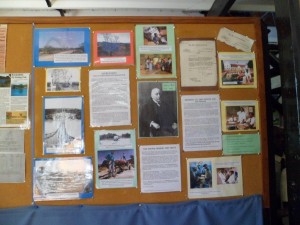
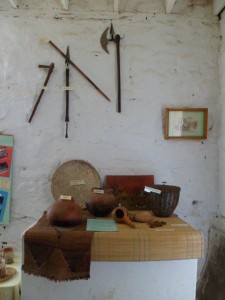
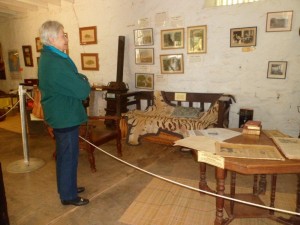
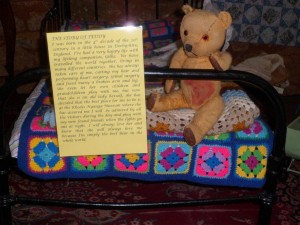
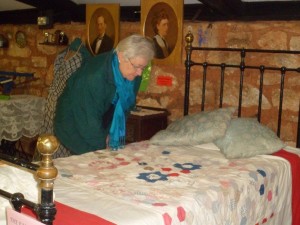
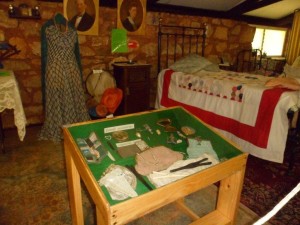
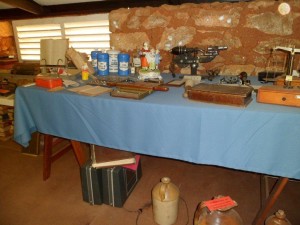
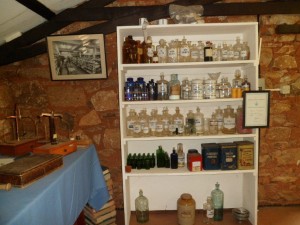
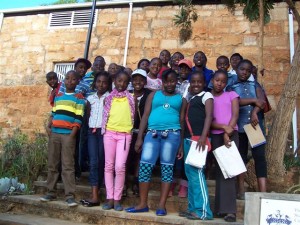
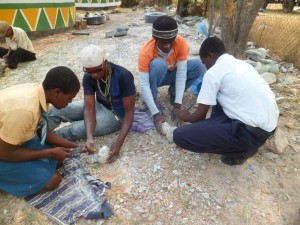
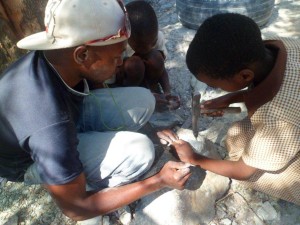
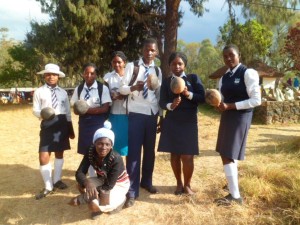
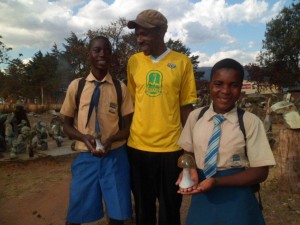
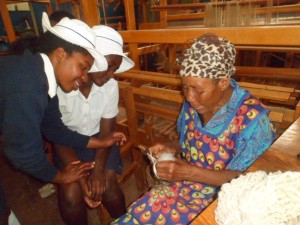

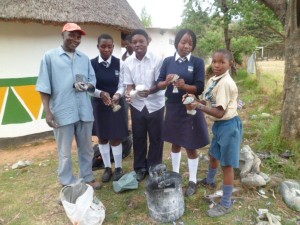

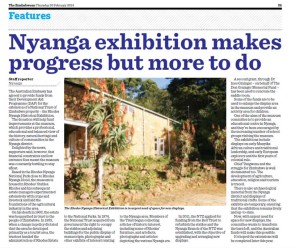

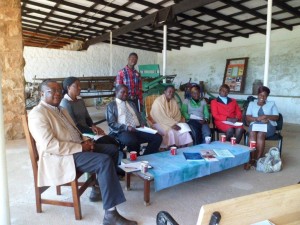
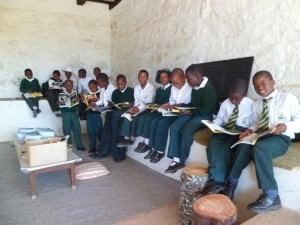


 USE NUMBER: 0775 907 595
USE NUMBER: 0775 907 595